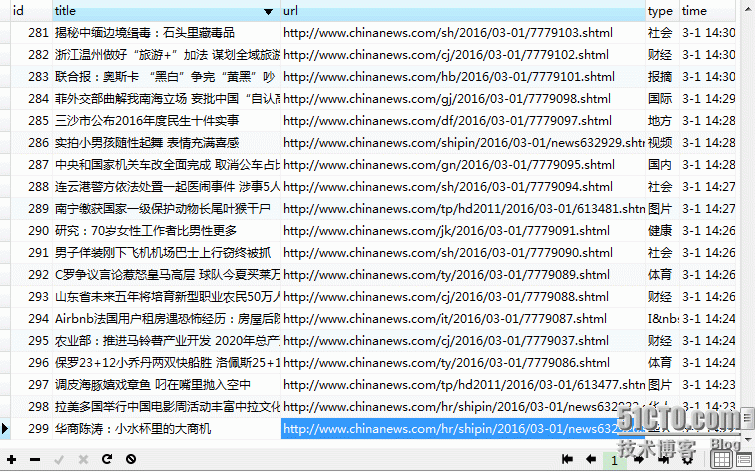Java基础系列6:计时器Timer与新闻的定时自动采集
Posted
tags:
篇首语:本文由小常识网(cha138.com)小编为大家整理,主要介绍了Java基础系列6:计时器Timer与新闻的定时自动采集相关的知识,希望对你有一定的参考价值。
一 Timer类与TimerTask类
在Java中要实现定时执行某项任务就需要用到Timer类和TimerTask类。其中,Timer类可以实现在某一刻时间或某一段时间后安排某一个任务执行一次或定期重复执行,该功能需要与TimerTask类配合使用。TimerTask类表示由Timer类安排的一次或多次重复执行的那个任务。
Timer类中的常用方法:
| 方法 | 描述 |
| void cancel() | 终止此计时器,丢弃所有当前已安排的任务,对当前正在执行的任务没有影响 |
| int purge() | 从此计时器的任务队列中移除所有已取消的任务,一般用来释放内存空间 |
| void schedule(TimerTask task, Date time) | 安排在指定的时间执行指定的任务 |
| void schedule(TimerTask task, Date firstTime, long period) | 安排指定的任务在指定的时间开始进行重复的固定延迟执行 |
| void schedule(TimerTask task, long delay) | 安排在指定延迟后执行指定的任务 |
| void schedule(TimerTask task, long delay, long period) | 安排指定的任务从指定的延迟后开始进行重复的固定延迟执行 |
| void scheduleAtFixedRate(TimerTask task, Date firstTime, long period) | 安排指定的任务在指定的时间开始进行重复的固定速率执行 |
| void scheduleAtFixedRate(TimerTask task, long delay, long period) | 安排指定的任务在指定的延迟后开始进行重复的固定速率执行 |
注:1)上面提到的时间的单位都是毫秒
2)schedule()方法和scheduleAtFixedRate()方法的区别在于重复执行任务时对于时间间隔出现延迟的情况的处理:schedule()方法的执行时间间隔永远是固定的,如果之前出现了延迟情况,那么之后也会继续按照设定好的时间间隔来执行;scheduleAtFixedRate()方法在出现延迟情况时,则将快速连续地出现两次或更多的执行,从而使后续执行能够“追赶上来”。从长远来看,执行的频率将正好是指定周期的倒数(假定 Object.wait(long) 所依靠的系统时钟是准确的)
二 一个定时任务范例
package javase.timer;
import java.text.Format;
import java.text.SimpleDateFormat;
import java.util.Date;
import java.util.Timer;
import java.util.TimerTask;
class MyTask extends TimerTask{
public void run() {
Format format = new SimpleDateFormat("yyyy-MM-dd HH:mm:ss:SSS");
System.out.println("当前时间:" + format.format(new Date()));
}
}
public class Demo {
public static void main(String[] args) {
Timer timer = new Timer();
timer.schedule(new MyTask(), 1000, 100); //1秒后执行,并且每隔100毫秒重复执行
try {
Thread.sleep(2000);
} catch (InterruptedException e) {
e.printStackTrace();
}
timer.cancel(); //终止计时器,放弃所有已安排的任务
timer.purge(); //释放内存
}
}输出:
当前时间:2016-03-01 15:02:36:451 当前时间:2016-03-01 15:02:36:477 当前时间:2016-03-01 15:02:36:578 当前时间:2016-03-01 15:02:36:678 当前时间:2016-03-01 15:02:36:778 当前时间:2016-03-01 15:02:36:878 当前时间:2016-03-01 15:02:36:978 当前时间:2016-03-01 15:02:37:078 当前时间:2016-03-01 15:02:37:178
从上面的代码可以看出,操作步骤跟线程是差不多的,首先是用一个类实现TimerTask接口,然后在run()方法里定义具体的任务,最后通过一个Timer实例定时调用这个任务执行(PS:实际上TimerTask实现了runnable接口,因此就少了我们很多的操作)
三 使用Timer实现的新闻定时自动采集
在这里,我选用的测试目标是“中国新闻网”的滚动新闻,链接是:http://www.chinanews.com/scroll-news/news1.html 。然后接下来的步骤就很明确了,设置定时任务定时去访问这个网页,然后每次访问时用正则表达式将我们需要的最新新闻的标题、URL、类型和时间提取出来,最后是保存到数据库中。完整代码如下:
package javase.timer;
import java.io.BufferedReader;
import java.io.IOException;
import java.io.InputStream;
import java.io.InputStreamReader;
import java.net.HttpURLConnection;
import java.net.MalformedURLException;
import java.net.URL;
import java.sql.Connection;
import java.sql.PreparedStatement;
import java.sql.ResultSet;
import java.sql.SQLException;
import java.util.ArrayList;
import java.util.List;
import java.util.Timer;
import java.util.TimerTask;
import java.util.regex.Matcher;
import java.util.regex.Pattern;
class CollectionTask extends TimerTask {
public void run() {
synchronized (this) {
List<String[]> news = getCurrentNews();
if (news.size() > 0)
saveNews(news);
}
}
/**
* 获取最新的“中国新闻网”的滚动新闻
*
* @return 最新滚动新闻的list列表
* */
private List<String[]> getCurrentNews() {
List<String[]> newsList = new ArrayList<String[]>();
try {
URL url = new URL("http://www.chinanews.com/scroll-news/news1.html");
HttpURLConnection connection = (HttpURLConnection) url
.openConnection();
connection.setRequestMethod("GET");
connection.setConnectTimeout(5000);
connection.setReadTimeout(5000);
if (connection.getResponseCode() == 200) {
InputStream inputStream = url.openStream();
// 注意编码问题,因为目标网页用的是gb2312,因此我这里也设置成gb2312,不然容易导致乱码
BufferedReader reader = new BufferedReader(
new InputStreamReader(inputStream, "gb2312"));
String line = "";
Pattern pattern = Pattern
.compile("<li><div class=\"dd_lm\">\\[<a href=.*?>(.+?)</a>\\]</div>.*?<div class=\"dd_bt\"><a href=\"([^\"]+)\">(.+)?</a></div><div class=\"dd_time\">(.+)?</div></li>");
Matcher matcher = null;
while ((line = reader.readLine()) != null) {
// System.out.println(line);
matcher = pattern.matcher(line);
if (matcher.find()) {
String[] news = new String[4]; // 存储每条新闻的各个元素的数组
news[0] = matcher.group(1); // 类型
news[1] = matcher.group(2); // URL
news[2] = matcher.group(3); // 标题
news[3] = matcher.group(4); // 时间
newsList.add(news);
}
}
// for(int i=0;i<newsList.size();i++){
// String[] temp = newsList.get(i);
// System.out.println("分类:" + temp[0] + " 标题:" + temp[2] +
// " URL:" + temp[1] + " 时间:" + temp[3]);
// }
reader.close();
inputStream.close();
connection.disconnect();
return newsList;
}
} catch (MalformedURLException e) {
e.printStackTrace();
} catch (IOException e) {
e.printStackTrace();
}
return newsList;
}
/**
* 保存新闻列表到数据库
*
* @param news
* 待保存的新闻列表
* */
private void saveNews(List<String[]> news) {
Connection connection = JDBCDemo.getConnection(); // 获取数据库连接
try {
PreparedStatement pStatement = null;
// 遍历,然后判断该条新闻是否已经在数据库中存在,不存在则保存
for (String[] temp : news) {
// System.out.println("分类:" + temp[0] + " 标题:" + temp[2] +
// " URL:"
// + temp[1] + " 时间:" + temp[3]);
pStatement = connection
.prepareStatement("select id from rollnews where url = ?");
pStatement.setString(1, temp[1]);
ResultSet resultSet = pStatement.executeQuery();
if (resultSet.next())
continue;
else {
pStatement = connection
.prepareStatement("insert into rollnews(title,url,type,time) values(?,?,?,?)");
pStatement.setString(1, temp[2]);
pStatement.setString(2, temp[1]);
pStatement.setString(3, temp[0]);
pStatement.setString(4, temp[3]);
pStatement.executeUpdate();
}
}
pStatement.close();
connection.close();
} catch (SQLException e) {
e.printStackTrace();
}
}
}
public class NewsCollection {
public static void main(String[] args) {
Timer timer = new Timer();
// timer.schedule(new CollectionTask(), 1000, 120000);
timer.scheduleAtFixedRate(new CollectionTask(), 1000, 120000);
}
}附:
(1)JDBCDemo.java:
package javase.timer;
import java.sql.Connection;
import java.sql.DriverManager;
import java.sql.SQLException;
public class JDBCDemo {
public static Connection getConnection(){
try {
Class.forName("com.mysql.jdbc.Driver");
return DriverManager.getConnection("jdbc:mysql://127.0.0.1:3306/news?useUnicode=true&characterEncoding=utf-8", "root", "root");
} catch (ClassNotFoundException e) {
e.printStackTrace();
} catch (SQLException e) {
e.printStackTrace();
}
return null;
}
}(2)SQL结构:
/* Navicat MySQL Data Transfer Source Server : sel Source Server Version : 50519 Source Host : localhost:3306 Source Database : news Target Server Type : MYSQL Target Server Version : 50519 File Encoding : 65001 Date: 2016-03-01 15:35:06 */ SET FOREIGN_KEY_CHECKS=0; -- ---------------------------- -- Table structure for rollnews -- ---------------------------- DROP TABLE IF EXISTS `rollnews`; CREATE TABLE `rollnews` ( `id` int(11) NOT NULL AUTO_INCREMENT, `title` varchar(255) NOT NULL, `url` varchar(255) NOT NULL, `type` varchar(255) NOT NULL, `time` varchar(255) NOT NULL, PRIMARY KEY (`id`) ) ENGINE=InnoDB AUTO_INCREMENT=300 DEFAULT CHARSET=utf8;
最后的效果如下:
每隔2分钟会访问目标网页一次,然后将获取到的新的新闻保存到数据库中
本文出自 “zifangsky的个人博客” 博客,请务必保留此出处http://983836259.blog.51cto.com/7311475/1747746
以上是关于Java基础系列6:计时器Timer与新闻的定时自动采集的主要内容,如果未能解决你的问题,请参考以下文章
定时器的实现java定时器Timer和Quartz介绍与Spring中定时器的配置
netty系列之:HashedWheelTimer一种定时器的高效实现
